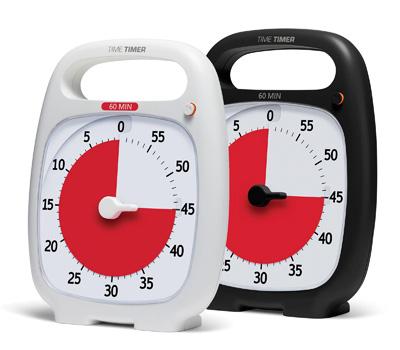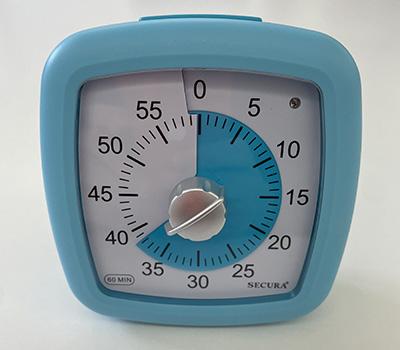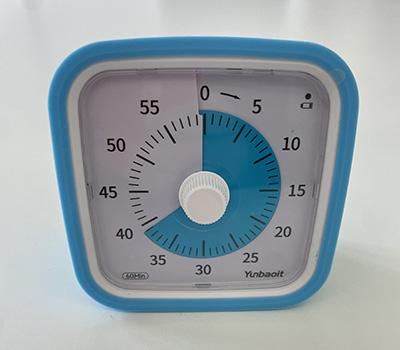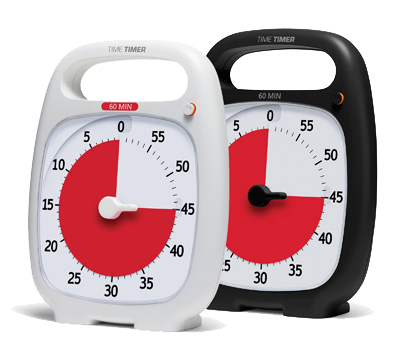Comparative Guide: 7 Best Visual Timers for Your Child
 Valérie Leroux - June 03, 2024
Valérie Leroux - June 03, 2024 Benefits of Using Visual Timers for Children | For Whom is a Visual Timer Suitable | Our Selection of Visual Timers | 7 Best Visual Timers for Your Child | Our choice: Time Timer Plus 60 Minute | Final Recommendations
If you’re struggling to get your child to:
- Complete their homework
- Switch from one activity to another
- Get to school on time
You’re not alone.
Visual timers can help by:
- Allowing children to see the passage of time
- Making it easier for them to transition between tasks
This guide will help you choose the best visual timer for your child, whether they have Attention Deficit Hyperactivity Disorder (ADHD) or not.
What are the Benefits of Using Visual Timers for Children?
Visual timers are colorful discs that act as visual countdowns. They help children understand time, reduce anxiety and improve focus. These timers encourage self-regulation from a young age and are useful for anyone with time management issues.
Managing time well every day helps your child become more independent, autonomous, and successful in their daily activities [1].
Children and teens with ADHD, in particular, often struggle with time perception: it’s hard for them to tell the difference between a few minutes and an hour [2]. A visual timer can help them understand these differences.
For Whom is a Visual Timer Suitable?
- ADHD or Attention Disorders: Helps focus on tasks by visually representing time.
- Autism: Structures the day and eases transitions between activities.
- School Difficulties: Visualizes task duration and waiting periods.
- Anxiety Disorders: Reduces stress by organizing daily activities.
- Families: Establishes routines and limits screen time.
- Healthcare and Education Professionals: Frames therapy sessions and activities.
| “ As an OT working with kids, I often use timers during sessions for several reasons. Timers help children anticipate how much time is left and allow them to adjust their pace in doing assigned tasks. This facilitates completion of homework, home chores, and other tasks on time. For children who have difficulties going from one task to another, using timers help facilitate easier transition to the next task. Regardless of the setting (at home, in school, during sessions) timers help prevent tantrums and parent-child power struggles.” Charles, school Occupational Therapist (OT) from New York |
| “ I’m now 27, but only got diagnosed with ADHD three years ago. When I was a kid, I always thought I could’ve done better if I only “tried” harder, without knowing it was ADHD hindering me from doing so. One of the things I’ve struggled with was time management. I always lose track of time especially when I’m doing something more interesting than school—I just tend to focus on that and not realize how much time I’ve lost. I would do my homework the same morning or even an hour before the task was due. I really didn’t really see it as a problem back then and continued to do it mainly because I didn’t get any bad consequences—I still pass and get OK grades. But looking back, I definitely had problems with time management. My mom would always remind me repeatedly, telling me it’s time to do this, it’s time to do that. At present, creating a routine, making lists, and using my device to look at the time, and set timers and alarms work well for me.“ Jon, 27 year old medical technologist in California |
Our Selection of Visual Timers
Choosing the right visual timer for your child can be challenging with so many options available. We’ve analyzed 7 timers priced between $10 and $40, each with different sizes, features and designs. While no study proves one timer is more effective than another, the best choice depends on its intended use—whether for daily activities, rehabilitation, or school.
Common Features of Visual Timers
- Sound Alarm: All timers beep when time ends.
- Silent Countdown: Most timers offer a silent countdown to avoid disruptions.
- Color Options: Timers are available in multiple colors.
- Manufacturing: Most visual timers are made in China, though quality can vary.
Criteria for Choosing the Right Visual Timer for Your Child
| Criteria | Tips for Choosing a Suitable Timer |
| Screen Type | Consider if your child may benefit more from an analog screen with a colored disc rather than a digital screen to better visualize time while reducing screen time. |
| Progression Visibility | Opt for a timer with a progression display that is easy for your child to read and understand. |
| Design | Choose a timer that matches your child’s preferences, considering shapes (round or square), colors (bright or pastel), and playful themes (like drawings or rainbows). |
| Countdown vs. Clockwise | Determine if a countdown mechanism, which helps children focus on the remaining time for a task, or a traditional clockwise mechanism suits your child better. |
| Programmable Duration | Look for a timer that allows you to set different durations (5, 20, 60, or 120 minutes) to match various activities. |
| Power Source | Consider whether a rechargeable battery with a USB port or traditional batteries with or without battery level indicators is more convenient for your family. |
| End Signal | Choose a timer that offers a flashing or sound-ending signal, with adjustable volume and duration settings to fit your child’s needs. |
| Protection | Select a timer with a silicone protective case or transparent protective flap for durability and protection. |
7 Best Visual Timers for Your Child
- Our top choice: Time Timer Plus 60 Minute
- The most famous: Mod Home Edition
- The most affordable: Yunbaoit TM021
- The most fun for your child: Liorque
- The most robust: Secura
- The most high-tech: Meesmeek Digital
- The best value for money: Yunbaoit VT 01
| Visual Timer Brand | Features | Reliability | Design | Value for money |
|---|---|---|---|---|
| Time Timer Plus 60 Minute | 📍📍📍 | ✔️✔️✔️ | 😍😍😍 | ⭐⭐⭐ |
| Mod Home Edition | 📍📍 | ✔️✔️✔️ | 😍😍😍 | ⭐⭐ |
| Yunbaoit TM021 | 📍📍 | ✔️✔️ | 😍😍 | ⭐⭐ |
| Liorque | 📍📍 | ✔️✔️ | 😍😍😍 | ⭐⭐⭐ |
| Secura | 📍📍 | ✔️✔️✔️ | 😍 | ⭐ |
| Meesmeek Digital | 📍 | ✔️✔️ | 😍😍 | ⭐⭐ |
| Yunbaoit VT 01 | 📍📍📍 | ✔️✔️ | 😍😍 | ⭐⭐⭐ |

Timer #1: Time Timer Plus 60 Minute
Description
The Time Timer Plus 60 Minute is a robust visual countdown timer designed to help children with ADHD manage time effectively.
Key Features
- Large, Easy-to-Read Dial: The timer has a big dial which is easy to read, even from afar. When set for an hour, it shows a full red disk, representing the full time. As time passes, the red disk shrinks, showing less time remaining.
- Pause Button: A unique feature which is ideal for kids needing breaks, as it helps them stay focused during activities longer than a few minutes.
- Silent Operation: Ensures no disruptions, letting children concentrate fully on their tasks.
- 60-Minute Countdown: Offers plenty of time for different activities and tasks.
Pros
- Durable Design: Built tough for everyday use, it won’t easily break or wear out.
- Effective Visual Cue: Helps kids see how much time they have left to finish tasks.
- Easy to Use: Simple design, easy for kids of all ages and abilities to use.
Cons
- Higher price ($40.95)
- Larger size: may not be ideal for carrying around or traveling.
| Our opinion: Our top choice We really like the pause button that stops activities, which helps restless children handle longer tasks. For children with ADHD or on the autism spectrum, this visual timer is a must-have. You can find it available for purchase here. |
Timer #2: Mod Home Edition
Description
The Time Timer Mod Home Edition is known for its modern design and counterclockwise operation. It is available in playful pastel colors.
Key Features
- Counterclockwise Operation: Provides a unique visual representation of time compared to traditional clocks.
- Variety of Color Options: Offers multiple pastel colors for personalization.
- Portable Design: Powered by an AA battery (not included), making it easy to use and transport.
Pros
- Sleek Design: Adds sophistication to any space.
- User-Friendly: Easy operation for both children and adults, promoting independence in time management.
- Portable: Compact and lightweight makes it easy to transport and convenient to use on the go.
Cons
- Limited Features: Lacks advanced features like volume adjustment for the sound or battery status indication.
- Slightly Higher Price ($19.95) compared to the Yunbaiot
| Our opinion: The most famous visual timer While the design is sleek, the plastic quality may not match the price. It lacks features like adjusting sound volume and duration, battery status indication, and a night light. Other models from the same brand offer more flexibility with timing options, better suited for therapy or school use, like the Time Timer Plus 60 Minute. |
Timer #3: Yunbaoit TM021
Description
The Yunbaoit TM021 is an affordable visual timer, perfect for budget-conscious parents. It’s a popular choice on Amazon.
Key Features
- Adjustable Alarm Volume: Users can customize the alarm volume to suit their needs.
- Practical Accessories: The upgraded version comes with useful extras like a silicone case for protection, a battery indicator, a night light, and the option to turn the alarm on or off as required.
Pros
- Affordable: The Yunbaoit TM021 provides good value for its price.
- Easy to Use: Its simple operation makes it suitable for children.
- Flexible: Adjustable alarm volume and useful accessories enhance its versatility.
Cons
- Basic Design: The design may seem basic compared to pricier models.
- Limited Features: It lacks advanced functions found in more expensive timers.
| Our Opinion: The most affordable visual timer The Yunbaoit TM021 provides a cost-effective and practical solution for time management. While its simple design and limited features may not appeal to all, the included accessories add value to its usability. Overall, it’s a suitable option for those seeking affordability and functionality. |
Timer #4: Liorque

Description
The Liorque timer aims to create a magical experience for kids with charming designs like clouds, rainbows, or marine scenes.
Key Features
- Whimsical Designs: The timer has playful visuals like clouds and rainbows to engage children.
Pros
- Kid-Friendly: Tailored to appeal to kids, it may make time management more enjoyable.
Cons
- Potential Distractions: The many visual details could distract some kids from tasks.
| Our Opinion: The most fun visual timer The Liorque timer offers a fun way to manage time, but you should consider if the visuals may be too distracting for your child. |
Timer #5: Secura

Description
The Secura timer is built tough for daily use, drawing from the brand’s kitchen equipment expertise.
Key Features
- Durability: It’s designed to handle everyday wear and tear.
- Hidden Buttons: Adjustment buttons are tucked away for protection.
- Red LED: Lights up when the buzzer is pressed but stays on, which may confuse users.
Pros
- Sturdy Build: Ideal for active kids.
- Hidden Buttons: Protects against accidental adjustments.
Cons
- Button Placement: Alarm adjustment may be inconvenient.
- Confusing LED: Its purpose isn’t clear.
- Slight ticking sound: May be distracting.
| Our Opinion: the most robust visual timer The Secura timer is robust but the ticking sound may be perceived in a silent environment. |
Timer #6: Meesmeek Digital

Description
The Meesmeek Digital timer offers advanced features with its attractive screen and visual countdown.
Key Features
- Handy magnet: For easy attachment to metal surfaces.
- Powered by rechargeable USB battery: Operates quietly.
Pros
- Versatility: Allows setting both minutes and hours.
- Portability: Can be easily moved and attached to various surfaces.
Cons
- Distracting Design: The constant ticking and flashing may distract kids.
- Curiosity Trigger: Its technological appearance may pique children’s curiosity, potentially disrupting focus.
| Our Opinion: The most high tech visual timer The Meesmeek Digital timer is feature-rich but may be more suitable for home use rather than during therapy or school sessions, due to its distracting design. |
Timer #7: Yunbaoit VT 01

Description
The Yunbaoit timer stands out as the best value for money, offering a silicone case for added protection.
Key Features
- Affordable: Priced at $17.99, making it budget-friendly.
- Protective Case: Includes a silicone case for maximum protection.
Pros
- Affordable: Priced at $17.99, making it budget-friendly.
- Robust: Its silicone case offers added durability and protection.
- Versatile: Suitable for various users, including those with attention disorders, autism, or learning disabilities.
Cons
- Limited Features: May lack some advanced functionalities found in more expensive timers.
| Our Opinion: The visual timer offering the best value for money We highly recommend the Yunbaoit timer for its affordability and practicality, making it an excellent choice for daily time management needs. |
Let’s Recap: Our Final Recommendations
Choosing the right visual timer can greatly help your child manage time and focus better. The Time Timer Plus 60 Minute stands out for its durability, ease of use and effectiveness. Explore various options to find what suits your child best.

Why the Time Timer Plus 60 Minute Ranked Highest
The Time Timer Plus 60 Minute combines durability, ease of use, and effectiveness, making it the best visual timer for ADHD.
Summary of Benefits
- Clear visual cue
- Robust design
- Simple to operate
FAQs: Common Questions from Parents regarding Visual Timers
How do visual timers help children with ADHD?
They provide a clear visual representation of time, helping children stay focused and manage transitions between tasks better.
Do timers work for kids with ADHD?
Although more research is needed, it is suggested that timers can help improve focus in children with ADHD [3].
How do you set a timer for ADHD?
Here’s an example when using the Time Timer Plus: to help your child finish their math homework.
- Set the Time Timer Plus for 20 minutes.
- Explain that when the red disk is gone, the work session is over.
- After 20 minutes, take a 5-minute break, using the timer to mark the break too.
Depending on your child’s age, they may be able to handle this process alone after a few times.
Disclaimer: This guide offers information on visual timers and their suitability for children with various needs. It does not replace professional medical advice for ADHD or any other health condition.
References
- Wennberg, B., Janeslätt, G., Kjellberg, A., & Gustafsson, P. A. (2018). Effectiveness of time-related interventions in children with ADHD aged 9-15 years: a randomized controlled study. European child & adolescent psychiatry, 27(3), 329–342. https://doi.org/10.1007/s00787-017-1052-5.
- Walg, M., Oepen, J., & Prior, H. (2015). Adjustment of Time Perception in the Range of Seconds and Milliseconds: The Nature of Time-Processing Alterations in Children With ADHD. Journal of attention disorders, 19(9), 755–763. https://doi.org/10.1177/1087054712454570
- Sluiter, M. N., Groen, Y., de Jonge, P., & Tucha, O. (2020). Exploring neuropsychological effects of a self-monitoring intervention for ADHD-symptoms in school. Applied neuropsychology. Child, 9(3), 246–258. https://doi.org/10.1080/21622965.2019.1575218




